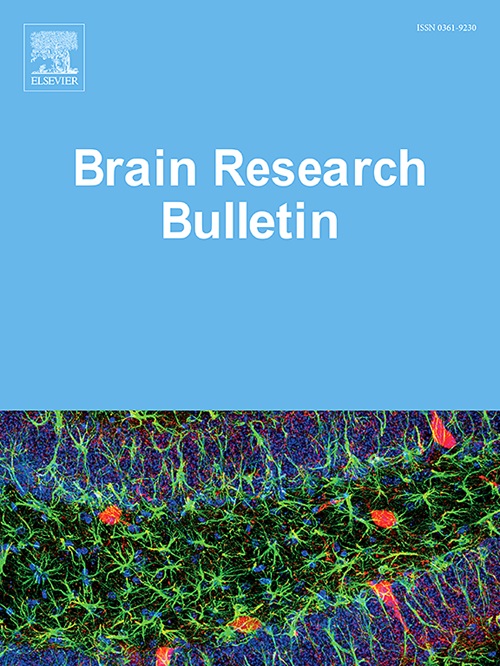PLB2Tau mice are impaired in novel and temporal object recognition and show corresponding traits in brain MRI
IF 3.5
3区 医学
Q2 NEUROSCIENCES
引用次数: 0
Abstract
Recent clinical trials targeting tau protein aggregation have heightened interest in tau-based therapies for dementia. Success of such treatments depends crucially on translation from non-clinical animal models. Here, we present the age profile of the PLB2Tau knock-in model of fronto-temporal dementia in terms of cognition, and by utilising a directly translatable magnetic resonance imaging approach. Separate cohorts of mice aged 3, 6 and 12 months were tested in an object recognition protocol interrogating visual, spatial, and temporal discrimination in consecutive tests. Upon completion of their behavioural testing, animals were recorded in a 7 T MRI for brain structural integrity and diffusion tensor imaging (DTI) analysis. We report that PLB2Tau mice presented with an age-dependent deficit in novel object discrimination relative to wild-type controls at 6 and 12 months. Spatial and temporal discrimination, though not significantly different from controls, appeared extremely challenging for PLB2Tau subjects, especially at 12 months, since they explored objects less than controls and were devoid of memory. Controls readily recalled all relevant object-related information. At the same time, the T2 weighted voxel-based image analysis revealed a progressive shrinkage of total brain volumes in 6- and 12-month-old PLB2Tau mice as well as relative striatal, but not hippocampal volumes. A regional DTI analysis yielded only reduced mean diffusivity of the fimbria, but not CA1 or dentate gyrus, amygdala, cingulate cortex, or corpus callosum. These data confirm the PLB2Tau mouse as a translationally useful model for dementia research and suggest the importance of the hippocampal input as a determinant for novel object discrimination.
PLB2Tau小鼠在新物体和时间物体识别上受损,并在脑MRI上表现出相应的特征。
最近针对tau蛋白聚集的临床试验提高了人们对基于tau蛋白的痴呆症治疗的兴趣。这种治疗的成功关键取决于从非临床动物模型的转化。在这里,我们通过使用直接可翻译的磁共振成像方法,从认知角度介绍了PLB2Tau敲入额颞叶痴呆模型的年龄概况。分别对3、6和12个月大的小鼠进行对象识别方案测试,在连续测试中询问视觉、空间和时间辨别。行为测试完成后,用7T MRI记录动物脑结构完整性和弥散张量成像(DTI)分析。我们报道,PLB2Tau小鼠在6个月和12个月时相对于野生型对照,在新物体识别方面表现出年龄依赖性缺陷。空间和时间辨别,虽然与对照组没有显著差异,但对于PLB2Tau受试者来说,似乎极具挑战性,特别是在12个月时,因为他们探索的物体比对照组少,而且缺乏记忆。控制组很容易回忆起所有与对象相关的信息。同时,基于T2加权体素的图像分析显示,6个月和12个月大的PLB2Tau小鼠的总脑体积以及相对纹状体体积逐渐缩小,但海马体积没有缩小。区域DTI分析仅显示毛的平均扩散率降低,但没有CA1或齿状回、杏仁核、扣带皮层或胼胝体。这些数据证实了PLB2Tau小鼠是一种可用于痴呆症研究的模型,并表明海马输入作为新物体识别的决定因素的重要性。
本文章由计算机程序翻译,如有差异,请以英文原文为准。
求助全文
约1分钟内获得全文
求助全文
来源期刊

Brain Research Bulletin
医学-神经科学
CiteScore
6.90
自引率
2.60%
发文量
253
审稿时长
67 days
期刊介绍:
The Brain Research Bulletin (BRB) aims to publish novel work that advances our knowledge of molecular and cellular mechanisms that underlie neural network properties associated with behavior, cognition and other brain functions during neurodevelopment and in the adult. Although clinical research is out of the Journal''s scope, the BRB also aims to publish translation research that provides insight into biological mechanisms and processes associated with neurodegeneration mechanisms, neurological diseases and neuropsychiatric disorders. The Journal is especially interested in research using novel methodologies, such as optogenetics, multielectrode array recordings and life imaging in wild-type and genetically-modified animal models, with the goal to advance our understanding of how neurons, glia and networks function in vivo.
 求助内容:
求助内容: 应助结果提醒方式:
应助结果提醒方式:


